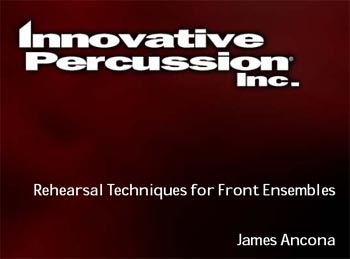Rehearsal Techniques for Front Ensembles
 The warm-up is over, and the ceremonial moving of pit equipment has been completed.
The warm-up is over, and the ceremonial moving of pit equipment has been completed.
It is time to rehearse with the entire ensemble. You, the instructor, must take advantage of your space! There are a few vantage points that will allow you to evaluate the music very effectively: in front of the pit, directly behind the pit and from the press box. In an ideal world, you would have enough staff members to place one person at each of these positions. If not, try to divide your time accordingly.


The warm-up is over, and the ceremonial moving of pit equipment has been completed.
It is time to rehearse with the entire ensemble. You, the instructor, must take advantage of your space! There are a few vantage points that will allow you to evaluate the music very effectively: in front of the pit, directly behind the pit and from the press box. In an ideal world, you would have enough staff members to place one person at each of these positions. If not, try to divide your time accordingly.
Standing In Front of the Pit
This is where much of your “cleaning” of the pit will happen. This is your chance to listen to the rhythmic clarity and consistency of interpretation from player to player. This is also a good time to check out the balance and blend within the pit. Is the xylophone over-balancing the vibraphone? Is the suspended cymbal drowning out the beautiful glockenspiel countermelody? This is the time to fix these issues. Since you’ve already warmed up with the metronome, you know the tendencies of your players. Besides their tendencies with rhythm and tempo, you also know their tendencies with balance, playing zones, consistency of sound, shaping and articulation. It will all show up here.
This is also a great time to check other important issues like vibe pedaling, dampening of various instruments, accessory technique and how well the pit “performs.”
Essentially, these are all of the things that you would be looking at and listening to in a sectional rehearsal (pit alone.) The only thing you would do differently in a sectional is that you would spend more time listening to individuals play.
Standing Behind the Pit
If you stand on the front sideline directly behind the pit, you are in the ultimate “hot spot.” This is a great spot to check timing issues. From this position, you can watch the drum major and check the timing between the field musicians and the pit.
Your first task in this process is to watch the drum major and see how well they are holding the tempo. Try to have a metronome to your ear and watch the drum major’s pattern. Besides checking for tempo maintenance, you can also check for pattern clarity and check to see where the major’s “focus” is. What section are they watching on the field and trying to keep in time?
The section to focus on will change from phrase to phrase. If the major feels like he or she is being pushed or pulled by the ensemble, have an instructor go to the back of the field with a metronome and speaker. This can be very revealing!
When the drum major is confident with their tasks, you can check the timing of the field percussion and winds. On the field, there are many situations that can affect their timing. Here are just a few common problems for the field musicians: slowing down during direction changes in the drill, the battery slowing down during rolls or difficult technical passages, slowing down going into halts, they may be inconsistent with tempo changes, retards or accelerandos, or their distance to the front sideline may affect their timing (if they are too close or too far.) During this process it is very important to make the pit aware of these tendencies. During a performance they will have to listen back and adjust to all of these “issues” coming from the field.
Standing In the Press Box
Standing in the press box or up in the bleachers will provide you with the best opportunity to address overall ensemble issues such as balance, blend, timing, and general effect. Before you head “up top,” spend some time directly behind the pit, as mentioned previously. This will help you to know the timing and tempo tendencies of the entire ensemble. From the press box, you will have a better view to see exactly what is causing these problems; particularly if they are drill related. Experiment with having the pit tacet during some reps.
This will highlight the backfield problems and allow you to address them. More importantly, as a pit instructor, this is your time to balance the front ensemble with the entire musical ensemble. You’ll find that there are certain instruments that often overbalance. Some of these include; suspended cymbals, tam tams, concert bass drums, xylophones and high metal sounds like crotales, glockenspiels and bell plates. These problems are usually easy fixes.
Simply, bring the performer’s dynamic level down or experiment with a softer mallet to see if that takes off some of the “edge.” If this doesn’t do it, perhaps that part is simply too overbearing for the full ensemble score. If this is the case, you may have to “thin-out” or remove the part.
If parts are under-balanced and not cutting through, the solution may not be so simple. Again, you may try to bring the dynamic level up or experiment with different mallets. More often, under-balanced parts are a scoring problem. Perhaps the part is too fast. This means the part will have to be played low to the keyboard resulting in a low dynamic level. Perhaps the part is scored too thin. Can it be played in octaves, or voiced with four-mallets, or played in a different octave? Sometimes the part may just be “uncomfortable” to play.
For example, a B major chord (B, D#, F#, B) sounds harmless enough, but simply doesn’t lie well under the hands. Uncomfortable parts can usually be fixed with very simple score edits or new stickings. Another very common problem is getting vibraphones and chimes to cut through. The solution to this may be very easy: be very generous with the pedal. Though leaving the pedal down for an entire phrase may sound awful to the performer, it will sound very full and lush to the audience. Even staccato chords can use a quick pedal to “open” up the sound. There are very few times when you don’t use the pedal.
Other important issues to address from the press box are “length of sound” and “tapering of sound.” There are several instruments in the pit who’s sustain has the ability to cover up or “mask” the sound of other instruments (in the pit or on the field.) Not only will this cause musical balance problems, but it may also prevent pit members from hearing what is happening on the field. This can cause serious ensemble problems. For example, if you strike a tam tam at forte, the sustain will last for several measures.
To prevent the tam tam’s sustain from covering up other sounds, you can taper its sounds by running your fingers across the instrument. Essentially, this makes the instrument die out quicker. You may also want to determine exactly
when you want to completely choke off the sound of the tam tam. This is the kind of detail that will lend clarity to your ensemble. Other instruments that fall into this category are suspended cymbals, concert bass drums, vibraphones
and crotales.
This article has been extracted from James’ recently released book, UP FRONT – a Complete Resource for Today’s Pit Ensemble, co-written with fellow Innovative Percussion Signature Artist, Jim Casella.
James Ancona is a percussion instructor for the six-time world champion Santa Clara Vanguard and has several years experience as an arranger and instructor for DCI corps, including the Boston Crusaders, the Crossmen, the Glassmen, Star of Indiana and The Santa Clara Vanguard. Several of his percussion arrangements appear on Star of Indiana’s “Brass Theater” and “BLAST” compact discs. Ancona received his Bachelor’s Degree in Music Education from
the University of Massachusetts at Amherst and his Master’s Degree in Performance from Indiana University where he was awarded the prestigious Performer’s Certificate.
He is the Assistant Director of the Blue Hen Marching Band, Director of the Basketball Pep Band and Co-Director of the Symphonic Band at the University of Delaware.
Related posts:
Short URL: https://trendmarching.or.id/read/?p=790




